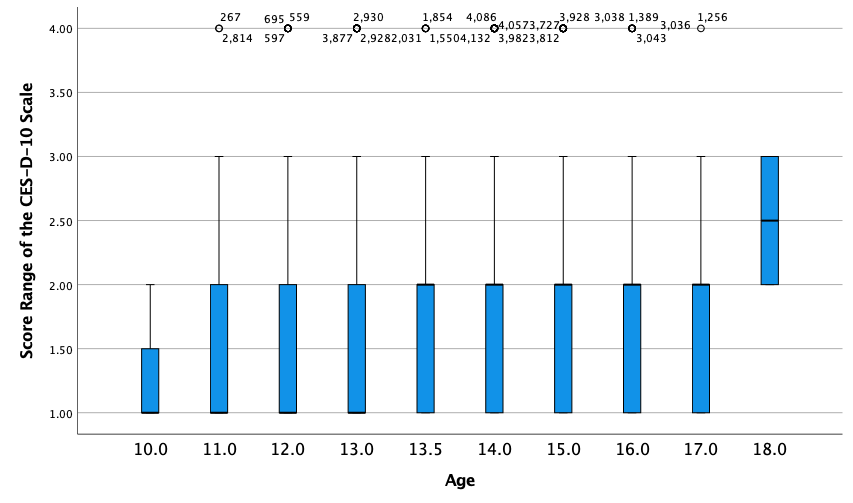

Volume 70
Published on June 2025Volume title: Proceedings of the 3rd International Conference on Interdisciplinary Humanities and Communication Studies

Depression has become a common mental disorder worldwide, and the incidence group is getting younger. In the Chinese context, data collected from surveys and news both indicate that parental maltreatment is one of the significant contributors to the increase in youth depression. This study focuses on studying the correlation between three types of parental maltreatment, which are parental absence, domestic violence, and verbal aggression, and the depressive symptoms severity measured by the CES-D-10 scale and a survey among Chinese adolescents aged between 10 and 18. It is hypothesized that the more parental maltreatment the participants experienced, the more severe depressive symptoms they displayed. Principal components that were extracted for each independent variable from the items in the survey were used in the Pearson correlational analysis and multiple regression analysis. The results suggest that parental maltreatments, including parental absence, domestic violence, and verbal aggression are scientifically significantly correlated with the CES-D-10 test scores of the participants. The more intimate the parent-child relationships are, the lower the CES-D-10 scores. The results of the multiple regression analysis indicate that the overall model is statistically significant, meaning that the set of independent variables significantly predicts the severity of depressive symptoms. This study contributes and provides data support on the topics of parental factors contributing to the increase in Chinese adolescents’ depression. Despite those contributions, it is essential to highlight the limitations, such as the influence of temporary factors on CES-D-10 scores and the potential lack of generalizability across different cultural contexts. Future research could focus on explaining individual differences in depressive symptoms using different measurement tools.

 View pdf
View pdf


This paper mainly explores how family factors influence code-mixing behaviors in Mandarin-English bilingual children’s daily communications in Asia. As globalization drives the importance of English as a lingua franca, many parents attach importance to bilingual education and intend to create environments to develop their children’s bilingual abilities. Code-mixing is the practice of mixing elements of two or more languages in a single conversation, sentence, or phrase. It is common among bilingual or multilingual speakers and reflects their ability to switch fluently between different languages. Through a comprehensive review of existing literature, this paper explores the family factors, such as parental language policies, attitudes, and practices, and provides key insights for educators and parents on the dynamics of language, culture, and identity in bilingual families, particularly within the Asian context.

 View pdf
View pdf



The Kizil caves, an archaeological site located in Kucha around the Tarim basin in Xinjiang, is a representation of Buddhist practice along the Silk Road. Many studies have been carried out on the art style and history of the mural paintings in Kizil caves, claiming a close connection with Central Asia and inner China. However, few scholars have researched its link with the commercial practices on the Silk Road, which greatly influenced and shaped the power and pattern of the Kucha kingdom. This article aims to study the relationship between Buddhism and commerce in ancient Kucha, diving deep into the mural paintings of the Kizil caves and their indications to commerce and goods along the Silk Road. This essay uses two caves as examples to support its argument, compares them with ruins and textual material in other regions, and obtains a deeper understanding of the commercial and religious practices in Kucha during the Sui and Tang dynasties.

 View pdf
View pdf



This article studies how Todd Haynes’ famous queer film Carol (2015) explores the delicate queer relationship through their complex emotions, subtle body language, and power dynamics. Carol is a film depicting how two women with distinct age and class gaps fall in love under the pressure of moral standards and social constraints in 1950s America. This article is divided into three sections. The first section is cantered on the emotions between Therese and Carol. The second section discusses the power dynamics between them. The third part focuses on body language in Carol’s cinematography. After the analysis, this article concludes that the complicated but profound emotions between Carol and Therese make their touches contained but ardent. Therefore, authoritarianism of power does not exist in their relationship, but fluidity of power does. In doing so, this article found out the equality, respects, irrationality and selfishness are all exist in Carol and Therese’s relationship, their love is profound, contained and relatively equal but also not perfect.

 View pdf
View pdf


This research focuses on the film adaptations of Jane Austen’s Pride and Prejudice (1813) in plots. Compared to Pride and Prejudice (1940) directed by Robert Leonard and Joe Wirght’s Pride and Prejudice (2005), this research explores the evolution of feminism and how these two film adaptations reflect on the waves of feminism during their periods. Robert Leonard’s Pride and Prejudice (1940) is relevant to the first wave of feminism while Pride and Prejudice (2005) by Joe Wright could relate to the third wave of feminism. To prove the points mentioned above, this research analyses the adaptations of plots in the 1940 and 2005 version and argues that both show association with the waves of feminism during their periods via plots adaptations. The connection between Pride and Prejudice (1940) and the first wave of feminism could be shown in the pursuit of women’s equal rights through adaptations. Meanwhile, Pride and Prejudice (2005) reflects on the third wave of feminism via advocacy of women’s empowerment and development, as well as the promotion of gender equality by challenging traditional values.

 View pdf
View pdf


Autism is a developmental disorder of the nervous system, the main symptom of which is a lag in verbal communication skills. Cognitive function, as an important ability, may affect the verbal communication ability of autistic patients. The aim of this study is to explore the reason why those children with autism have a difficulty in communication, and to confirm the role of cognitive function. This study adopted the experimental method and recruited 200 non-autistic children and children with different degrees of autism as subjects. Natural observation and questionnaire survey were used to verify the influence of autism degree on verbal communication ability of patients, and explore the mediating role of cognitive function. The hypotheses of this study is that the cognitive function will influence the communication skill of children with autism, and play a mediating role, and the result is there are differences in communication skill between non-autistic children and children with autism, and the degree of autism and the cognitive function causes those differences between the communicative competence in autism and typical children.

 View pdf
View pdf


This research explores the best practices of luxury brands in utilizing social media to engage younger demographics, specifically millennials and Gen Z. As these groups gain more influence over the luxury sector, conventional marketing methods—such as lavish fashion shows and print ads—are proving less effective. Platforms like Facebook, Instagram, and TikTok have become essential for luxury brands aiming to reach these young consumers. The study begins by analyzing the advantages and disadvantages of various social media marketing strategies, including influencer partnerships, word-of-mouth (WOM) on social platforms, and premium pricing tactics. Influencer collaborations have been shown to significantly impact consumer perceptions and buying choices; however, there is a potential risk if an influencer's actions do not align with the brand’s values. Word-of-mouth on social media serves as a powerful mechanism for influencing purchasing intentions but requires careful management to protect the brand's image. Setting high prices can effectively foster brand loyalty and exclusivity; nonetheless, it is crucial to balance this with quality online service to maintain consumer confidence. In summary, this research enhances our understanding of how luxury brands can utilize social media effectively to attract younger audiences while offering actionable recommendations for improving brand equity, business outcomes, and sales performance.

 View pdf
View pdf



Chinese calligraphy and poetry are important components of Chinese traditional culture, with profound historical significance and cultural symbols. In the vicissitudes of history, they have experienced wars and various factors have led to them not being given important attention. But their place in the Chinese cultural system cannot be ignored. In particular, the relationship between poetry and Chinese calligraphy was important in the Central Plains Dynasty's control of Dunhuang. By analyzing the unearthed relics of Dunhuang calligraphy works and the original poems unearthed in Dunhuang, this study explores how Chinese calligraphy and poetry reflect the changes of ancient history and their impact on society. Research shows that these art forms are not only the expression of personal feelings and thoughts, but also important materials for historical research. It can confirm the appearance of politics and society at that time from the side, and provide valuable materials for modern scholars to study history, so that we can better understand the evolution of Chinese history and cultural integration.

 View pdf
View pdf



In this paper, we study the impact of director's gender on visual and narrative style of cinema about lesbian from the perspective of the male gaze, by comparing Fingersmith(Walsh, 2005) and The Handmaiden (Park, 2016). Both films are based on the same novel, Fingersmith (Waters, 2003). The former is directed by a female director, while the latter is directed by a male director. This paper discusses studied objects from four aspects, in terms of intimacy, sexuality, betrayal and the closure of the films. Therefore, it concludes that even though male directors want to remove the male gaze when creating movies about lesbians, they still cannot fully avoid the influence of the male gaze, thereby illustrating the significant of gender as an influencing factor in this context. It is important to note that the concept of the male gaze, as discussed in this article, is employed to analyse the film as an aesthetic and ideological system, rather than as a biological criterion that focuses on the director's physical identity. This thesis will contribute to the research of male gaze in cinemas about lesbian.

 View pdf
View pdf


This article presents an analysis of the social functions ascribed to Jiugao and Historiae during the Western Zhou period in China and in the early Scythian civilisation. While regulating the conditions under which wine may be consumed, Jiugao also ascribes very important ethical attributes and functions to wine. In Jiugao, the necessary indoctrination, national laws and ideologisation are applied to the otherwise simple act of drinking alcohol. While in Herodotus: On the Scythians, wine is an integral part of the sacrifice, and is also closely associated with warfare. The act of "drinking" is directly linked to one's military prowess and social status. There are fundamental differences between the Zhou and Scythian cultures. The fact that the Zhou culture was a subsistence agricultural civilisation, while the early Scythian culture was a nomadic civilisation living on water and grass, is the main reason why the two cultures assigned different social functions to wine.

 View pdf
View pdf




